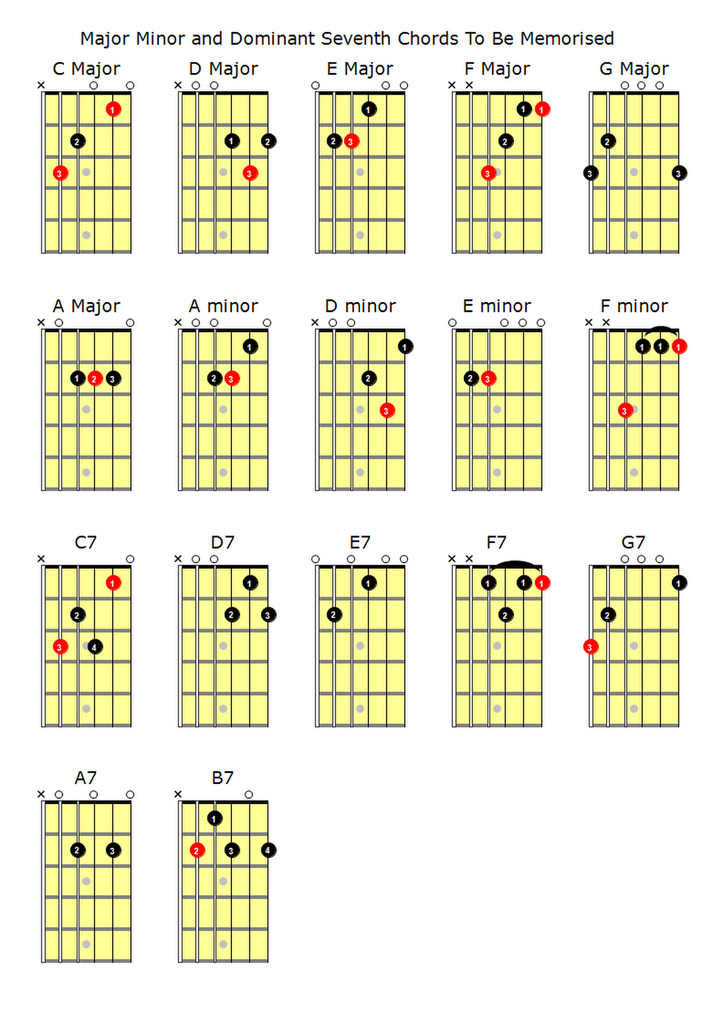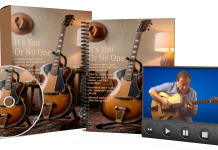This post may contain affiliate links. As an Amazon associate, Google associate as well as associate for other programs, Guitar & Music Institute may earn commissions from qualifying purchases.
Learning how to play guitar chords is an essential step for beginners. By mastering basic strumming patterns, you can start playing your favorite songs on the guitar. This article will provide step-by-step instructions and tips for beginners to learn easy guitar chords and start strumming. With practice and patience, you’ll be strumming along to your favorite tunes in no time.
Key Takeaways:
- Beginners can start playing guitar by learning easy chords and strumming patterns.
- Practice regularly and have patience to improve your guitar playing skills.
- Explore different musical styles by incorporating various strumming patterns.
- Keep discovering new songs and styles to expand your musical abilities.
Some Basic Guitar Chords For Beginners

Understanding Strumming Patterns and Techniques
Strumming is a rhythmic technique used to play chords on the guitar. It involves striking or sweeping the strings with a pick or fingers. Understanding guitar strumming patterns and techniques is crucial for beginners who want to master this fundamental skill. By learning different strumming patterns and applying the right techniques, you can add depth and dynamics to your playing.
The Importance of Strumming Patterns
Strumming patterns are the rhythmic patterns used to create the groove and feel of a song. They determine the strumming direction, duration, and emphasis on particular beats. As a beginner, it’s essential to learn and practice various strumming patterns for different musical styles. This will allow you to play songs accurately and replicate the desired sound.
Developing Good Strumming Technique
Before diving into specific patterns, it’s important to develop a solid foundation for your strumming technique. Here are some tips to help you get started:
- Hold the guitar pick correctly: Position the pick between your thumb and index finger with a firm grip. Experiment with different pick sizes and materials to find what feels comfortable for you.
- Relax your strumming hand: Avoid tension in your wrist and forearm. Strumming should feel fluid and effortless.
- Use a consistent and controlled motion: Strum with a smooth up-and-down motion, keeping your hand relaxed and loose. Start by practicing simple downstrokes and gradually incorporate upstrokes.
- Focus on accuracy and timing: Practice strumming with a metronome or along with a song to improve your timing. Pay attention to the rhythm and ensure each strumming motion lands on the right beat.

Mastering Various Strumming Patterns
Now that you have a solid technique, it’s time to explore different strumming patterns. Below, you’ll find a table with examples of common strumming patterns for beginners:
| Strumming Pattern | Description |
|---|---|
| Downstrokes Only | A simple pattern where you strum all the strings in a downward motion. |
| Down-Up | An alternating pattern where you strum down and then strum up. |
| Down, Down-Up | A pattern with two downstrokes followed by an upstroke. |
| Missed Downstrums | A pattern where you intentionally skip some downstrokes for a syncopated feel. |
| Up-Up-Down-Up | A more advanced pattern with multiple upstrokes and a downstroke. |
Practice these strumming patterns slowly and gradually increase your speed as you become more comfortable. It’s important to start with a metronome and maintain a steady rhythm. Remember to focus on accuracy and clarity as you strum each pattern.
Combining different strumming patterns with guitar chords will allow you to create unique sounds and explore a wide range of musical genres. Experiment with these patterns and incorporate them into your playing to enhance your guitar skills and musical expression.
For more in-depth tutorial videos and resources on guitar strumming patterns and techniques, check out our latest guitar books and downloads at https://gmiguitarshop.com/.
Learning Basic Strumming Patterns
Are you ready to take your guitar playing to the next level? In this section, we’ll explore a variety of basic strumming patterns that are perfect for beginners like you. Whether you’re strumming an acoustic guitar or an electric one, these patterns will help you develop your rhythmic skills and create different musical feels and grooves.
To make it easier for you to learn, each strumming pattern will be accompanied by tabs and audio samples. This way, you can visually see the pattern and hear how it sounds. Ready to get started? Let’s dig in!
Simple Downstrokes
This is the most basic strumming pattern that every beginner should learn. It involves simply strumming down with your pick or thumb on the strings of your guitar in a steady rhythm. This pattern is commonly used in many songs and provides a solid foundation for your strumming technique.
| Strumming Pattern | Tab | Audio Sample |
|---|---|---|
| Downstrokes | – | Listen |
Practice this pattern with basic chords like G, C, and D, and gradually increase your speed and accuracy. Remember to maintain a consistent rhythm and keep your strums evenly spaced.
Upstrokes and Downstrokes
Once you’ve mastered the simple downstroke pattern, it’s time to add some variation by incorporating upstrokes. This pattern involves strumming down on the downbeat and up on the upbeat, creating a more dynamic and rhythmic sound.
| Strumming Pattern | Tab | Audio Sample |
|---|---|---|
| Down, Up, Down, Up | – | Listen |
Try this pattern with chords like A, E, and Dm, and experiment with different combinations to create your own unique strumming patterns.
Syncopated Strumming
If you’re looking for a more advanced strumming pattern, try incorporating syncopation. This technique adds emphasis on the offbeats, creating a syncopated rhythm that can add a bit of flair to your playing.
| Strumming Pattern | Tab | Audio Sample |
|---|---|---|
| Down, Down, Up, Down, Up | – | Listen |
With practice, this pattern can add complexity and excitement to your playing. Try it out with chords like Em, D7, and G7 to create a groovy vibe.

Remember, practice is key when learning strumming patterns. Start slow and gradually increase your speed as you become more comfortable with each pattern. With dedication and consistency, you’ll be strumming along to your favorite songs in no time!
Exploring Different Musical Styles with Strumming Patterns
In this section, we’ll explore how different strumming patterns can be used to create specific musical styles. Whether you want to play rock, reggae, or other genres, understanding the unique strumming patterns associated with each style is essential. By practicing these patterns and incorporating them into your playing, you’ll be able to capture the essence of various musical genres and expand your repertoire.
Guitar Strumming Styles
Before diving into specific strumming patterns, let’s take a moment to discuss some common guitar strumming styles. Each musical genre has its own distinct sound and feel, often characterized by the strumming technique used.
- Rock: Rock music is known for its energetic and aggressive strumming patterns. Strumming patterns in rock often involve a combination of downward and upward strokes, creating a driving rhythm that complements the powerful nature of the genre.
- Reggae: Reggae music is characterized by its laid-back, syncopated strumming style. Strumming patterns in reggae often feature a steady downbeat with accents on the upbeat, creating a relaxed and groovy feel.
- Other Genres: Each musical genre, from folk to jazz to pop, has its own unique strumming style. By exploring different genres and their associated strumming patterns, you can broaden your musical horizons and develop a versatile playing style.
Strumming Patterns for Different Genres
Now, let’s dive into some specific strumming patterns for different genres:
| Genre | Strumming Pattern |
|---|---|
| Rock | Down, down, up, up, down, up |
| Reggae | Down, up, up, down, up |
| Folk | Down, down, down, up, down, up |
| Jazz | Down, up, down, up, down, up |
Remember, these are just a few examples, and there are countless strumming patterns to explore for different genres. Experiment with different patterns, tempos, and dynamics to find the strumming style that best suits your musical taste.

If you’re looking for more strumming patterns and resources, check out our latest free and paid guitar books and downloads at https://gmiguitarshop.com/.
Conclusion
Congratulations on mastering the basics of guitar chords and strumming patterns for beginners! With consistent practice and a solid foundation, you can continue to develop your skills and explore more advanced techniques.
Remember that learning and playing the guitar is a journey, so make sure to have fun along the way. Enjoy the process of discovering new songs and styles that resonate with you, and don’t be afraid to experiment with different strumming techniques.
To further support your guitar journey, we invite you to check out our wide range of free and paid guitar books and downloads at https://gmiguitarshop.com/. These resources will provide you with additional learning materials and inspiration to help you continuously improve as a guitarist.
Keep strumming, keep practicing, and keep pushing yourself to new heights. Beginner guitar lessons can only take you so far, but with dedication and a love for music, you have the ability to become an accomplished guitarist. Don’t stop here – the world of guitar strumming techniques is waiting for you to explore!
FAQ
What are some easy beginner guitar chords?
Some easy beginner guitar chords include G, C, D, E, and A. These chords are commonly used in many popular songs and provide a good starting point for beginners.
How do I learn guitar chords?
Learning guitar chords can be done through various methods, such as online tutorials, guitar lesson books, or taking lessons from a guitar instructor. It’s important to practice regularly and focus on proper hand placement and finger positioning.
Are there any charts available for beginner guitar chords?
Yes, there are beginner guitar chord charts available online and in guitar lesson books. These charts provide visual representations of chord shapes and finger placements, making it easier for beginners to learn and memorize chords.
Can I learn guitar chords without previous musical experience?
Absolutely! Learning guitar chords is a great starting point for beginners with no previous musical experience. With practice and dedication, anyone can learn to play chords and strum the guitar.
How long does it take to learn guitar chords?
The time it takes to learn guitar chords varies for each individual. It depends on factors such as practice consistency, natural aptitude, and previous musical experience. With regular practice, most beginners can learn the basic chords within a few weeks or months.
Can I play songs using only beginner guitar chords?
Yes, many popular songs can be played using only beginner guitar chords. By mastering a few basic chords and learning simple strumming patterns, beginners can play a wide range of songs.
How can I improve my strumming technique?
To improve your strumming technique, it’s important to start with basic strumming patterns and practice them slowly and accurately. Focus on developing a consistent rhythm and timing. Regular practice and experimentation with different strumming patterns will help you improve over time.
Are there specific strumming patterns for different musical styles?
Yes, different musical styles often have specific strumming patterns associated with them. For example, reggae music typically uses a “down-up” strumming pattern, while rock music may incorporate more aggressive and dynamic strumming techniques. By studying different strumming patterns, you can broaden your musical repertoire and adapt to various genres.
Where can I find additional resources and materials to support my guitar learning journey?
Our website offers a variety of free and paid guitar books and downloads that can support your guitar learning journey. Visit our online guitar shop and get GMI’s download easy guitar chord book for beginners.
Source Links
- https://www.fachords.com/guitar-strumming-patterns/
- https://www.stringkick.com/blog-lessons/strumming-patterns/
- https://www.hellosimply.com/blog/guitars/strumming-patterns/
This post may contain affiliate links. As an Amazon associate, Google associate as well as associate for other programs, Guitar & Music Institute may earn commissions from qualifying purchases.



























